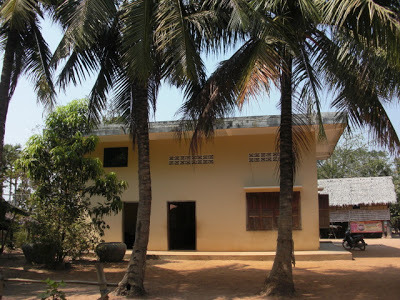COETAIL--Changing the Way the World Learns...in Cambodia?
After reading the blog post Disrupting Class--An Overview, about Clayton Christensen, Michael Horn and Curtis Johnson's book
Disrupting Class: How Disruptive Innovation Will Change the Way the World Learns
I've downloaded the book to my Kindle. I haven't had a chance to skim through Disrupting Class yet, but the blog post raises interesting questions.
The post explains that disruptive innovation within the educational sphere is taking place in two phases--computer-based learning followed by student-centric learning focused on customization that "will allow the teachers, parents and the learner to customize the system to help learners to learn each subject in the ways that their brains are wired to learn."
The post raises some interesting questions at the end and led to my own reflections, especially as I am about to depart for Cambodia where for part of my stay I'll spend five days in a village as a volunteer teacher in a free after-school English school. According to World Bank data, Cambodia's internet users per 100 people number a mere 3.1. In the village where I will stay, many huts have no electricity. Few people have computers. Classes at this school are in a simple school room.

 The teachers there teach following their teacher role models--as heads of the classroom, pointing to words on the whiteboard. The children take turns with the pointer reciting the sentence example.
The teachers there teach following their teacher role models--as heads of the classroom, pointing to words on the whiteboard. The children take turns with the pointer reciting the sentence example.
 The last time I visited the village in 2010, I used my earnings from an international school visit to purchase the head teacher his own computer. But the reality is, he has to travel an hour by motorbike to Phnom Penh for Internet access. My travel gift this year is a solar lamp from Ikea.
The last time I visited the village in 2010, I used my earnings from an international school visit to purchase the head teacher his own computer. But the reality is, he has to travel an hour by motorbike to Phnom Penh for Internet access. My travel gift this year is a solar lamp from Ikea.
Meanwhile at the opposite end of the spectrum, many students in other parts of the world in both public and private schools have one-to-one laptop usage, are already in the customization phase, and teachers have a community of experienced educators with whom to learn from and share ideas both face-to-face and online.
Given the state of affairs in Cambodia and other developing countries around the world, perhaps in addition to enabling access to clean water and education, we in the developed world should be establishing innovative ways to create more hubs of internet access, in schools and in the form of libraries containing both print materials and internet connected computers, to also function as centers for teachers to develop as twenty-first century educators.
Education throughout the world seems to be divided into technology haves and have nots. Can we train technology leaders and educators in these developing countries to help them customize education approaches to suit their needs? Will politics and cultural tradition stifle such efforts? In Confucian influenced Asia, how easily can the traditional teacher roles shift? I look forward to observing the Cambodian village classroom and hope to conduct a survey of internet access with the students I meet.
The post explains that disruptive innovation within the educational sphere is taking place in two phases--computer-based learning followed by student-centric learning focused on customization that "will allow the teachers, parents and the learner to customize the system to help learners to learn each subject in the ways that their brains are wired to learn."
The post raises some interesting questions at the end and led to my own reflections, especially as I am about to depart for Cambodia where for part of my stay I'll spend five days in a village as a volunteer teacher in a free after-school English school. According to World Bank data, Cambodia's internet users per 100 people number a mere 3.1. In the village where I will stay, many huts have no electricity. Few people have computers. Classes at this school are in a simple school room.

 The teachers there teach following their teacher role models--as heads of the classroom, pointing to words on the whiteboard. The children take turns with the pointer reciting the sentence example.
The teachers there teach following their teacher role models--as heads of the classroom, pointing to words on the whiteboard. The children take turns with the pointer reciting the sentence example.  The last time I visited the village in 2010, I used my earnings from an international school visit to purchase the head teacher his own computer. But the reality is, he has to travel an hour by motorbike to Phnom Penh for Internet access. My travel gift this year is a solar lamp from Ikea.
The last time I visited the village in 2010, I used my earnings from an international school visit to purchase the head teacher his own computer. But the reality is, he has to travel an hour by motorbike to Phnom Penh for Internet access. My travel gift this year is a solar lamp from Ikea.Meanwhile at the opposite end of the spectrum, many students in other parts of the world in both public and private schools have one-to-one laptop usage, are already in the customization phase, and teachers have a community of experienced educators with whom to learn from and share ideas both face-to-face and online.
Given the state of affairs in Cambodia and other developing countries around the world, perhaps in addition to enabling access to clean water and education, we in the developed world should be establishing innovative ways to create more hubs of internet access, in schools and in the form of libraries containing both print materials and internet connected computers, to also function as centers for teachers to develop as twenty-first century educators.
Education throughout the world seems to be divided into technology haves and have nots. Can we train technology leaders and educators in these developing countries to help them customize education approaches to suit their needs? Will politics and cultural tradition stifle such efforts? In Confucian influenced Asia, how easily can the traditional teacher roles shift? I look forward to observing the Cambodian village classroom and hope to conduct a survey of internet access with the students I meet.
Published on February 01, 2013 19:06
No comments have been added yet.



